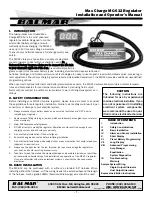
- 11 -
Max Charge MC-612
Quick Installation Instructions
IMPORTANT
The following information is essential to the proper operation of your Max Charge regulator. Do not install or oper-
ate before reviewing the following:
1
1..
P
Po
os
siittiiv
ve
e B
Ba
atttte
erryy S
Se
en
ns
se
e W
Wiirre
e - User supplied -- not in harness. This wire must be connected to the regulator and to a source
of positive battery voltage (see #3 on reverse for mounting location) to provide proper regulator operation. The regulator
WILL NOT WORK if the Positive Battery Sense Wire is not connected to the regulator and is not sensing battery voltage.
The Positive Battery Sense Wire must be fused. A 1/8-amp fuse is included with the regulator and harness kit.
2
2..
G
Grro
ou
un
nd
diin
ng
g - The Model MC-612 must be properly grounded to regulate accurately. The two ground wires located in the har-
ness must be securely attached to their terminals and the alternator’s preferred ground to ensure proper grounding. A
grounding strap between the alternator’s preferred ground and the preferred ground at the engine is strongly recommend-
ed.
3
3..
V
Vo
olltta
ag
ge
e R
Re
ea
ad
diin
ng
gs
s - MC-612 digital circuitry is engineered to monitor battery charge state and automatically compensate
for changes in battery voltage during operation. As a result, it is NOT unusual to see near-constant changes in the regula-
tor’s Battery Voltage display. These voltage changes reflect the regulator’s ability to make precise corrections to optimize
charging efficiency.
5
5..
E
Elle
ec
cttrriic
ca
all T
Ta
ac
ch
ho
om
me
ette
errs
s - Many OEM and aftermarket tachometers require an AC pulse from the alternator to drive the
tachometer. If you are using an electrical tachometer that is being driven off of your alternator's stator pulse, plug the
white stator wire into the terminal provided on the regulator, and the tach feed into the Tach Out terminal. If you are not
using the stator pulse to drive your tachometer, DO NOT plug the stator wire into the regulator's Stator connection.
When using the alternator and regulator to drive your tachometer, there is a possibility that you will see system voltage
creeping up when your batteries are fully charged. This occurs as a result of the regulator's effort to provide a "blip" of volt-
age to the alternator to keep the tachometer feed activated. This voltage creep can usually be reduced or eliminated by
increasing the load on the batteries, ie., turning on a few cabin lights or cabin fans, until the batteries are allowed to
accept charging voltage.
4
4..
D
Du
ua
all-O
Ou
uttp
pu
utt O
Op
pe
erra
attiio
on
n - When using the MC-612 with a dual-output alternator it is essential to ensure that the regulator
senses the largest battery bank. The positive Battery sense wire must be attached on the alternator output terminal con-
nected to the larger battery bank. If your system includes a large house battery and a smaller starting battery, there is the
possibility that the smaller battery may see excess surface voltage during charging. Ensure that your smaller battery is
inspected regularly for electrolyte levels. If optional Battery Temperature Sensors are used, we recommend attaching the
#1 Battery Temperature Sensor to the smaller bank. This ensures that the alternator output will be reduced if the starting
battery temperature exceeds safe operating temperatures.
5
5..
A
Alltte
errn
na
atto
orr &
& B
Ba
atttte
erryy T
Te
em
mp
pe
erra
attu
urre
e S
Se
en
ns
so
orrs
s ((o
op
pttiio
on
na
all)) - The optional Alternator Temperature Sensor monitors for over-tem-
perature conditions at the alternator. If ambient temperatures outside of safe limits are detected, the regulator will reduce
alternator output to 50% and will activate an alarm circuit. NOTE: This option is not intended to be used as part of regular
operation. If circuit is activated, inspect and repair the system immediately. Optional Battery temperature sensing can
compensate for both over-temperature conditions and for operation in conditions where ambient battery temperatures are
below 26°(C) by varying field voltage. It is not unusual to see charging voltage rise safely above normal levels when bat-
tery temperatures are below 26°(C).
6
6..
M
Ma
ag
gn
ne
ettiic
c R
Re
ee
ed
d S
Sw
wiittc
ch
h - Not all magnets are alike. You may find that one magnet will activate the reed switch with little
effort, while another similar magnet may require a bit of maneuvering to find the switch’s “sweet spot.” If you have difficul-
ty adjusting program modes, be sure to check for the dot at the top of the LED to ensure that you are activating the switch.












